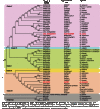Monolignol ferulate conjugates are naturally incorporated into plant lignins
- PMID: 27757415
- PMCID: PMC5065250
- DOI: 10.1126/sciadv.1600393
Monolignol ferulate conjugates are naturally incorporated into plant lignins
Abstract
Angiosperms represent most of the terrestrial plants and are the primary research focus for the conversion of biomass to liquid fuels and coproducts. Lignin limits our access to fibers and represents a large fraction of the chemical energy stored in plant cell walls. Recently, the incorporation of monolignol ferulates into lignin polymers was accomplished via the engineering of an exotic transferase into commercially relevant poplar. We report that various angiosperm species might have convergently evolved to natively produce lignins that incorporate monolignol ferulate conjugates. We show that this activity may be accomplished by a BAHD feruloyl-coenzyme A monolignol transferase, OsFMT1 (AT5), in rice and its orthologs in other monocots.
Keywords: BAHD transferase; DFRC; GC-MS; Grasses; lignin; monocot; monolignol; phylogenetic tree; rice; transgenic.
Figures




Similar articles
-
Modification of plant cell walls with hydroxycinnamic acids by BAHD acyltransferases.Front Plant Sci. 2023 Jan 17;13:1088879. doi: 10.3389/fpls.2022.1088879. eCollection 2022. Front Plant Sci. 2023. PMID: 36733587 Free PMC article. Review.
-
Enhancing monolignol ferulate conjugate levels in poplar lignin via OsFMT1.Biotechnol Biofuels Bioprod. 2024 Jul 13;17(1):97. doi: 10.1186/s13068-024-02544-y. Biotechnol Biofuels Bioprod. 2024. PMID: 39003470 Free PMC article.
-
Crystal structure of the plant feruloyl-coenzyme A monolignol transferase provides insights into the formation of monolignol ferulate conjugates.Biochem Biophys Res Commun. 2022 Feb 26;594:8-14. doi: 10.1016/j.bbrc.2022.01.037. Epub 2022 Jan 13. Biochem Biophys Res Commun. 2022. PMID: 35066379
-
Suppression of CINNAMOYL-CoA REDUCTASE increases the level of monolignol ferulates incorporated into maize lignins.Biotechnol Biofuels. 2017 May 2;10:109. doi: 10.1186/s13068-017-0793-1. eCollection 2017. Biotechnol Biofuels. 2017. PMID: 28469705 Free PMC article.
-
Trends in lignin modification: a comprehensive analysis of the effects of genetic manipulations/mutations on lignification and vascular integrity.Phytochemistry. 2002 Oct;61(3):221-94. doi: 10.1016/s0031-9422(02)00211-x. Phytochemistry. 2002. PMID: 12359514 Review.
Cited by
-
Modification of plant cell walls with hydroxycinnamic acids by BAHD acyltransferases.Front Plant Sci. 2023 Jan 17;13:1088879. doi: 10.3389/fpls.2022.1088879. eCollection 2022. Front Plant Sci. 2023. PMID: 36733587 Free PMC article. Review.
-
Rapid Biocatalytic Synthesis of Aromatic Acid CoA Thioesters by Using Microbial Aromatic Acid CoA Ligases.Chembiochem. 2023 May 2;24(9):e202300001. doi: 10.1002/cbic.202300001. Epub 2023 Apr 12. Chembiochem. 2023. PMID: 36821718 Free PMC article.
-
Rice Genome-Scale Network Integration Reveals Transcriptional Regulators of Grass Cell Wall Synthesis.Front Plant Sci. 2019 Oct 18;10:1275. doi: 10.3389/fpls.2019.01275. eCollection 2019. Front Plant Sci. 2019. PMID: 31681374 Free PMC article.
-
Overexpression of the scopoletin biosynthetic pathway enhances lignocellulosic biomass processing.Sci Adv. 2022 Jul 15;8(28):eabo5738. doi: 10.1126/sciadv.abo5738. Epub 2022 Jul 13. Sci Adv. 2022. PMID: 35857515 Free PMC article.
-
Simultaneous suppression of lignin, tricin and wall-bound phenolic biosynthesis via the expression of monolignol 4-O-methyltransferases in rice.Plant Biotechnol J. 2024 Feb;22(2):330-346. doi: 10.1111/pbi.14186. Epub 2023 Oct 5. Plant Biotechnol J. 2024. PMID: 37795899 Free PMC article.
References
-
- Bonawitz N. D., Chapple C., The genetics of lignin biosynthesis: Connecting genotype to phenotype. Annu. Rev. Genet. 44, 337–363 (2010). - PubMed
-
- Ralph J., Lundquist K., Brunow G., Lu F., Kim H., Schatz P. F., Marita J. M., Hatfield R. D., Ralph S. A., Christenen J. H., Boerjan W., Lignins: Natural polymers from oxidative coupling of 4-hydroxyphenylpropanoids. Phytochem. Rev. 3, 29–60 (2004).
-
- Boerjan W., Ralph J., Baucher M., Lignin biosynthesis. Annu. Rev. Plant Physiol. Plant Mol. Biol. 54, 519–546 (2003). - PubMed
-
- Upton B. M., Kasko A. M., Strategies for the conversion of lignin to high-value polymeric materials: Review and perspective. Chem. Rev. 116, 2275–2306 (2016). - PubMed
-
- FitzPatrick M., Champagne P., Cunningham M. F., Whitney R. A., A biorefinery processing perspective: Treatment of lignocellulosic materials for the production of value-added products. Bioresour. Technol. 101, 8915–8922 (2010). - PubMed
LinkOut - more resources
Full Text Sources
Other Literature Sources
Miscellaneous

